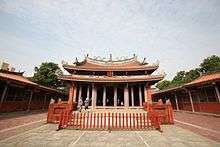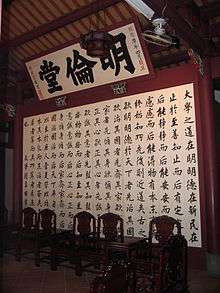Taiwan Confucian Temple
| Taiwan Confucian Temple 臺灣孔廟 | |
|---|---|
 | |
| Basic information | |
| Location | West Central District, Tainan, Taiwan |
| Affiliation | Confucian |
| Region | southern Taiwan |
| Status | Active |
| Website | http://confucius.culture.tw/ |
| Architectural description | |
| Architectural type | Temple |
| Architectural style | Southern Chinese |
| Completed | 1665 |
| Direction of façade | South |
The Taiwan Confucian Temple (Chinese: 臺灣孔廟), also called Tainan Confucian Temple (臺南孔子廟) or Quan Tai Shou Xue (全臺首學) is a Confucian temple on Nanmen Road in Tainan, Taiwan. Coordinates: 22°59′25″N 120°12′15″E / 22.99028°N 120.20417°E
History
The Taiwan Confucius Temple, also called the Scholarly Temple, was built in 1665 during the Koxinga dynasty, when Zheng Jing (Koxinga's son) approved of the proposal by Chief of General Staff Chen Yonghua to construct the Temple on the right side and the National Academy (to be called "Guo Xue" hereafter) on the left side of a hill, with both facing the south. On the east (left) side stood Ming-Lun Hall (明倫堂; Hall of Ethics), built as a place for instructors to offer lectures and cultivate intellectuals. On the west(right) side was the sanctuary called Ta-Cheng Hall (大成殿; Hall of Great Achievement), housing the mortuary tablet of Confucius, as well as those of his distinguished disciples. The Wen Miao (文廟) and Guo Xue compound, the first of its kind in the history of Taiwan, was thus called the First Academy of Taiwan.[1]
In 1685, soon after the island of Formosa was annexed by the Qing Dynasty, the first Taiwan Regional Chief Administrator Chou Chang (周昌) and Taiwan Prefecture Magistrate Chiang Yu-ying (蔣毓英) began their efforts to have the Wen Miao renovated and the Ta-Cheng Hall reconstructed into Taiwan Prefecture Academy. Since then, the compound has been renovated and expanded several times. In 1712, following a major renovation by Taiwan Chief Administrator Chen Ping (陳璸), the compound retained its original layout of Wen Miao to the right and Guo Xue to the left. In the Wen Miao, in addition to its Ta-Cheng Hall, a gate named Ta-Cheng Gate (Gate of Great Achievement) was erected at its front yard and a shrine named Chung-Sheng Shrine (Shrine of Confucius' Ancestors) was built in its backyard. The Ta-Cheng Hall was flanked by East-Wu and West-Wu, two chambers in the worship of ancient scholars, while the Ta-Chen Gate stood between Wen-Chang Shrine (Shrine of Scholars) to the left and Tu-Di Shrine (Shrine of the Land) to the right. Also built on both sides of the yard of the Ta-Cheng gate were two walls with the addition of Li Gate (Gate of Rites) and Yi Road (Path of Righteousness). In the academy, a gate named Ju-Te-Chih-Men (Gate of Involving in Virtue) was erected as a main entrance to the Ming-Lun Hall, the main hall of Taiwan Prefecture Academy. Situated between the gate and the hall was a courtyard flanked by Chambers of the Six Arts, while seated behind the hall were residential chambers for faculty. To the east of the Ming-Lun Hall was the Chu Tzu Altar in worship of the scholar Chu Hsi. At this point, the construction of the Wen Miao had developed approximately into its current shape and scale.[2]
The Wen Miao continued to undergo several renovations in the wake of major renovation by Chen Ping. In 1777, Taiwan Prefecture Magistrate Chiang Yuan-shu (蔣元樞) undertook a major renovation. When Taiwan was established as a province in 1887, Taiwan-fu (modern-day Tainan) became the seat of the newly created Tainan Prefecture, and was renamed Tainan-fu. Thus, the Wen Miao was renamed Tainan Prefecture Academy. After 1895, Taiwan was under Japanese rule, the Wen Miao was once again used as a public school and military barracks and was considerably damaged. A major renovation in 1917, under which some parts of the construction were torn down, resulted in the scale and structure of the Wen Miao as it is today. The temple has been renovated several times over the past 300 years, most recently between 1987 and 1989.[2]
Today the temple serves as a popular tourist attraction and also preserves ancient Confucian ceremonies, which are conducted on a regular basis. The temple also includes storerooms for the ritual implements and musical instruments that are used in these ceremonies.
Geographical clarification
The Taiwan Confucius Temple in Tainan should not be confused with the much newer Taipei Confucius Temple located on Dalong Street in Taipei. 25°4′21″N 121°30′59″E / 25.07250°N 121.51639°E The temple in Taipei was built between 1879 and 1884.[3]
2008 unrest
On October 22, 2008, Zhang Mingqing, the vice chairman of the Chinese Association for Relations across the Taiwan Strait (ARATS), was attacked by Democratic Progressive Party (DPP) supporters during his visit to the Tainan Confucius Temple. The DPP city-councillor of Tainan City, Wang Ding-yu, who was believed to have summoned and led the protesters, deliberately knocked Zhang down and dragged him for several metres; however, he later denied any involvement in the incident. Three of Zhang's plainclothes police guards from Tainan Police Station had their arms folded and quietly watched the matter unfold. When Zhang entered his car and attempted to leave, one protester climbed atop the car and stomped on its roof while his colleagues cheered. Wang Ding-yu was later sentenced to 18 months in jail, with various lengths for other protesters.
Gallery of images
- The gate of Taiwan's Confucian Temple.
 chiwen at the Temple.
chiwen at the Temple. Dismounting stele written in Manchurian and Chinese reminding people to dismount their horse.
Dismounting stele written in Manchurian and Chinese reminding people to dismount their horse.
- The Paifang which is across from Tainan Confucian Temple.
See also
References
- ↑ "The Confucius Temple". Gio.gov.tw. Retrieved 2011-01-01.
- 1 2 Tainan Confucius Temple Historical Information Booklet. Page 2. 2009
- ↑ website for the Taipei temple
External links
| Wikimedia Commons has media related to Tainan Confucius Temple. |
- Visiting PRC official mobbed in Tainan (English)
- Taiwan Confucian Temple official site - part of this relates to the temple in Taipei! (English)
- Taiwan Confucian Temple official site (Chinese)
- Taiwan Confucian Temple page, with many photos
- Taiwan Confucian Temple page
- History of the Taiwan Confucian Temple
- Article about Taiwan Confucian Temple